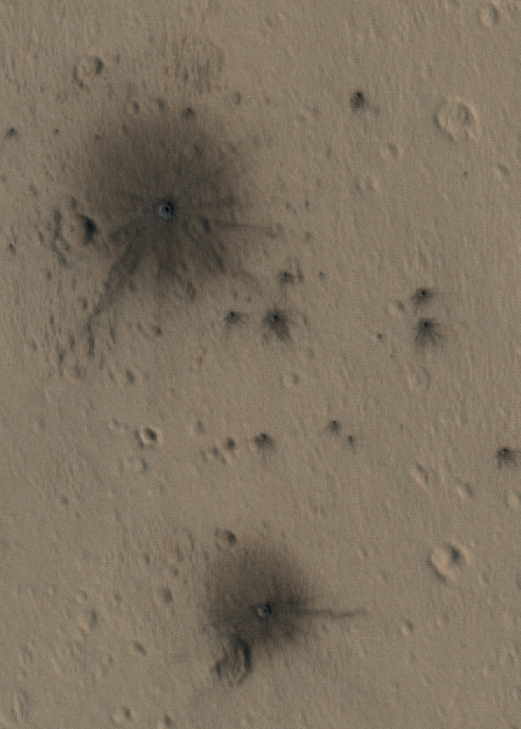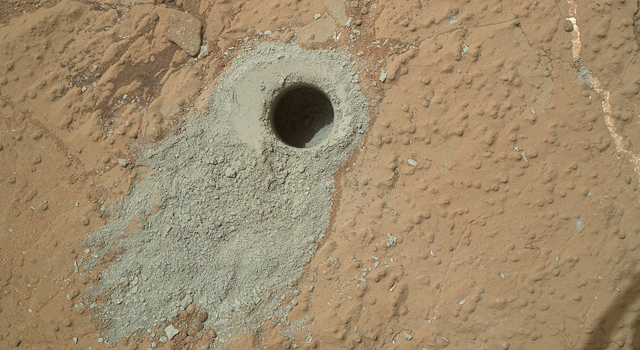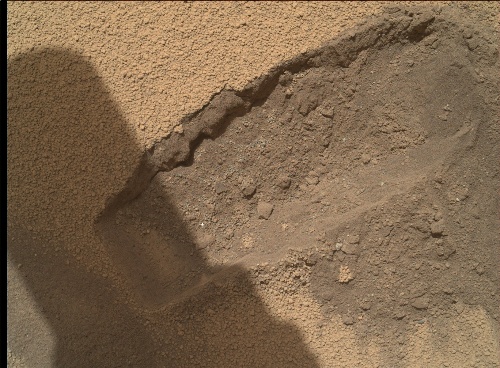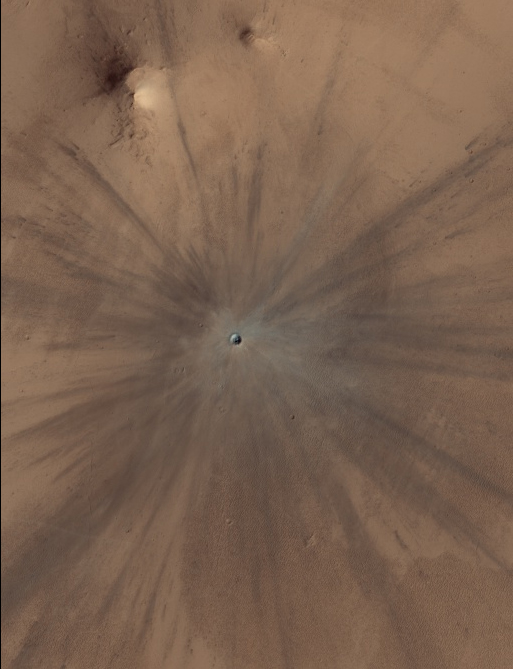It looks like you're using an Ad Blocker.
Please white-list or disable AboveTopSecret.com in your ad-blocking tool.
Thank you.
Some features of ATS will be disabled while you continue to use an ad-blocker.
share:
The Mars Reconnaissance Orbiter team spotted and photographed in high-rez a cluster of very fresh impact craters:
enhanced-colour view

www.uahirise.org...
true-colour view

I love photos of relatively fresh craters on Mars and other space bodies, as it shows our Solar System to be a dynamic place where stuff is happening every day. This case is especially cool as it shows that the metoroid encountered lots of air resistance and exploded or disintegrated into many pieces before striking the ground. I imagine it would have been a spectacular sight if watched from the ground.
Also interesting to see that the bedrock below the light reddish coating on Mars can be so dark. I've mostly seen light-grey bedrock from Curiosity images:
(upclose photo of a drilled rock)

although it could be darker sand:

~~~
Here's another relatively fresh impact crater on Mars:

enhanced-colour view

The dark spots in this enhanced-color infrared image are the recent impact craters that occurred in the Tharsis region between 2008 and 2014. These impact craters were first discovered by the Mars Context Camera (or CTX, also onboard the Mars Reconnaissance Orbiter) as a cluster of dark spots. The meteoroid that formed these craters must have broken up upon atmospheric entry and fragmented into two larger masses along with several smaller fragments, spawning at least twenty or so smaller impact craters.
www.uahirise.org...
true-colour view

I love photos of relatively fresh craters on Mars and other space bodies, as it shows our Solar System to be a dynamic place where stuff is happening every day. This case is especially cool as it shows that the metoroid encountered lots of air resistance and exploded or disintegrated into many pieces before striking the ground. I imagine it would have been a spectacular sight if watched from the ground.
Also interesting to see that the bedrock below the light reddish coating on Mars can be so dark. I've mostly seen light-grey bedrock from Curiosity images:
(upclose photo of a drilled rock)

although it could be darker sand:

~~~
Here's another relatively fresh impact crater on Mars:

edit on 8-2-2017 by wildespace because: (no reason given)
a reply to: wildespace
That third picture seems odd...
A direct hole that looks as if the impact was from directly above (giving the appearance of a drill hole) but however what looks like debris splattered to only one side? (would that debris not be debris that would normally be seen from an object coming from an angle instead of directly straight above?)
Any explanations from our space/physics boffins for us uneducated plebs?
Warmest
Lags
That third picture seems odd...
A direct hole that looks as if the impact was from directly above (giving the appearance of a drill hole) but however what looks like debris splattered to only one side? (would that debris not be debris that would normally be seen from an object coming from an angle instead of directly straight above?)
Any explanations from our space/physics boffins for us uneducated plebs?
Warmest
Lags
edit on 8-2-2017 by Lagomorphe because: Phrase added
a reply to: Lagomorphe
It is a drill hole.
From the Curiosity Rover.
It is a drill hole.
From the Curiosity Rover.
edit on 8/2/17 by Chadwickus because: (no reason given)
a reply to: Lagomorphe
Yes, sorry I didn't specify. It's a close-up photo from the Curiosity rover after it drilled a hole in the ground.
Yes, sorry I didn't specify. It's a close-up photo from the Curiosity rover after it drilled a hole in the ground.
a reply to: wildespace
Why is it that when I look at those pictures I get the urge to squeeze the pus out of them?
I hate pimples. Pimples must die.
Cool photos though!
Why is it that when I look at those pictures I get the urge to squeeze the pus out of them?
I hate pimples. Pimples must die.
Cool photos though!
a reply to: wildespace
The cosmic shotgun found its mark!
What fantastic images! The darkness of the material beneath the surface is probably something to do with the surface material having been exposed to more discolouration as a result of sunlight exposure, than the material underneath it. These impacts though... beautiful.
I am really glad you shared these with us, wildespace. Thank you!
The cosmic shotgun found its mark!
What fantastic images! The darkness of the material beneath the surface is probably something to do with the surface material having been exposed to more discolouration as a result of sunlight exposure, than the material underneath it. These impacts though... beautiful.
I am really glad you shared these with us, wildespace. Thank you!
originally posted by: wildespace
(upclose photo of a drilled rock)
although it could be darker sand:
the drill hole in a slab of rock indicates the rock is composed of lighter colored minerals
the uncovered 'sand' might well be 'darker' because of possible moisture content ?? ...that possibility would change the whole site exploration selection process on the planet
a reply to: St Udio
Indeed.
If the darker colour is an indicator of moisture being present in some form, then that would absolutely change the way the next exploration of the Martian surface is conducted. Of course, it could just be that the top layer is bleached by the sun, what with the atmosphere being quite thin on Mars, providing therefore, not an insurmountable barrier to the sunlight.
Indeed.
If the darker colour is an indicator of moisture being present in some form, then that would absolutely change the way the next exploration of the Martian surface is conducted. Of course, it could just be that the top layer is bleached by the sun, what with the atmosphere being quite thin on Mars, providing therefore, not an insurmountable barrier to the sunlight.
Thanks lifeless rock for sucking up another lifeless rock so this one we inhabit doesn't also become lifeless.
Seriously though, is it me or have there been a lot of recent impacts across our little neighborhood of planets recently. Stay away from us and just make cool looking craters elsewhere please.
Seriously though, is it me or have there been a lot of recent impacts across our little neighborhood of planets recently. Stay away from us and just make cool looking craters elsewhere please.
originally posted by: St Udio
the uncovered 'sand' might well be 'darker' because of possible moisture content ?? ...that possibility would change the whole site exploration selection process on the planet
No. I believe it has more to do with the sun "bleaching" the darker sand rather than any kind of evaporation.
@ St Udio and TrueBrit
It's neither. The dark sand is just basaltic sand, there's huge dunes of it in many places on Mars (including Curiosity's current location).

The light-toned coating over almost all of Mars is Iron Oxide (aka rust), nothing to do with bleaching by the Sun.
It's neither. The dark sand is just basaltic sand, there's huge dunes of it in many places on Mars (including Curiosity's current location).

The light-toned coating over almost all of Mars is Iron Oxide (aka rust), nothing to do with bleaching by the Sun.
How big would those craters be do you reckon?
Would it be possible for a rover to explore them?
All those fresh craters are surrounded with ejecta from beneath the surface, much deeper than a rover's drill can achieve.
I'm no scientist in any sense of the word but if I were, I would be itching to get a rover to that area lol.
Perhaps the next rover they send could be designed to fly or hover so it can travel to other locations? A bit like a 'Transformer'-ish type of contraption.
Just thinking out loud. Cool pics op. S&F
Would it be possible for a rover to explore them?
All those fresh craters are surrounded with ejecta from beneath the surface, much deeper than a rover's drill can achieve.
I'm no scientist in any sense of the word but if I were, I would be itching to get a rover to that area lol.
Perhaps the next rover they send could be designed to fly or hover so it can travel to other locations? A bit like a 'Transformer'-ish type of contraption.
Just thinking out loud. Cool pics op. S&F
a reply to: wildespace
Wow!
Fair enough! Those dunes though! I would love to have a go at those with a dune buggy of some sort. In actual fact, I would love to walk on them. Look at those amazing details in that shot!
Wow!
Fair enough! Those dunes though! I would love to have a go at those with a dune buggy of some sort. In actual fact, I would love to walk on them. Look at those amazing details in that shot!
MRO team just released this video, talking more about fresh craters: www.youtube.com...
Such craters are usually a few meters across. I've calculated that the largest of the bunch of craters in my original post is about 6 meters across.
New craters on Mars are easiest to locate in such dust-coated terrains, where they provide opportunistic "road cuts" that allow scientists to see beneath the dust blanket. (Audio: www.tregibbs.com. Black and white images are 5 km across; enhanced color images are less than 1 km.) www.uahirise.org...
Such craters are usually a few meters across. I've calculated that the largest of the bunch of craters in my original post is about 6 meters across.
edit on 9-2-2017 by wildespace because: (no reason given)
originally posted by: Chadwickus
a reply to: Lagomorphe
It is a drill hole.
From the Curiosity Rover.
That's either a really high res camera or an enormous rover.
new topics
-
Which chapter of the apocalypse is raining fish?
Jokes, Puns, & Pranks: 18 minutes ago -
Sweet Home Alabama (metal cover by Leo Moracchioli)
Music: 1 hours ago -
FBI confirms new leads connected to DNA evidence and cellphone data in disturbing killings of elderl
Other Current Events: 4 hours ago -
Moyes No Longer Blowing Bubbles
World Sports: 4 hours ago -
Breaking--Hamas Accepts New Cease Fire
Middle East Issues: 5 hours ago -
Soros, Rockefeller and Pritzker, according to a POLITICO analysis Back Palestinian protests
US Political Madness: 5 hours ago -
Tornado Obliterates Nebraska Building with Furious Anger
Fragile Earth: 5 hours ago -
They say justice is blind.
Religion, Faith, And Theology: 5 hours ago -
Liberal Democrats to Table a Motion of No Confidence in the government Tomorrow
Regional Politics: 7 hours ago -
Time Traveler Caught on Camera?
Paranormal Studies: 8 hours ago
top topics
-
Medvedev: “No one can hide, a global catastrophe is coming”
World War Three: 9 hours ago, 15 flags -
Trump legal cases are falling apart at break neck speeds
US Political Madness: 8 hours ago, 15 flags -
We are screwed
Global Meltdown: 8 hours ago, 14 flags -
Soros, Rockefeller and Pritzker, according to a POLITICO analysis Back Palestinian protests
US Political Madness: 5 hours ago, 12 flags -
Breaking--Hamas Accepts New Cease Fire
Middle East Issues: 5 hours ago, 8 flags -
Tornado Obliterates Nebraska Building with Furious Anger
Fragile Earth: 5 hours ago, 6 flags -
Time Traveler Caught on Camera?
Paranormal Studies: 8 hours ago, 6 flags -
Liberal Democrats to Table a Motion of No Confidence in the government Tomorrow
Regional Politics: 7 hours ago, 4 flags -
FBI confirms new leads connected to DNA evidence and cellphone data in disturbing killings of elderl
Other Current Events: 4 hours ago, 4 flags -
Sweet Home Alabama (metal cover by Leo Moracchioli)
Music: 1 hours ago, 3 flags
active topics
-
Which chapter of the apocalypse is raining fish?
Jokes, Puns, & Pranks • 4 • : Encia22 -
Candidate TRUMP Now Has Crazy Judge JUAN MERCHAN After Him - The Stormy Daniels Hush-Money Case.
Political Conspiracies • 1268 • : Oldcarpy2 -
Medvedev: “No one can hide, a global catastrophe is coming”
World War Three • 156 • : Oldcarpy2 -
Breaking--Hamas Accepts New Cease Fire
Middle East Issues • 38 • : KrustyKrab -
EPA sues San Francisco for dumping billions of gallons of sewage into Pacific Ocean
US Political Madness • 23 • : SchrodingersRat -
Time Traveler Caught on Camera?
Paranormal Studies • 26 • : CarlLaFong -
Trump legal cases are falling apart at break neck speeds
US Political Madness • 26 • : Asher47 -
The Dark Pyramid of Alaska and the Why Files take on the subject
Whistle Blowers and Leaked Documents • 24 • : SchrodingersRat -
Leading Surgeon from Al-Shifa Hospital Dies in Israeli Custody
Middle East Issues • 70 • : Xtrozero -
Zionists of ATS assemble
Political Issues • 190 • : Xtrozero
